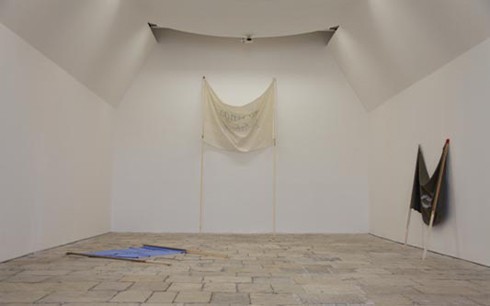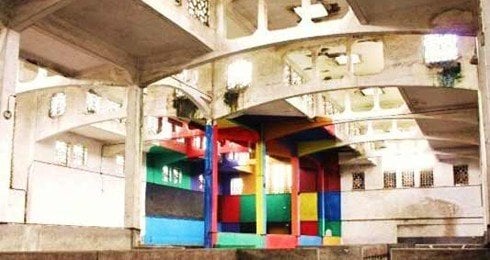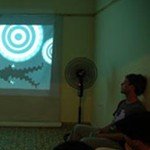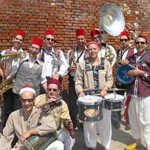
The place is outstanding and the sight is striking. Youngsters challenge each other on skateboards and rollerblades between the different buildings decorated with laces of concrete announcing the Art Deco. The "Beirut" hall, name given due to the rubble found in it, hosts today the rehearsals of groups of actors and musicians. In the main building, artists set up their installations under the rails that used to carry butchery hooks. In spite of its 82 years, the Casablanca old slaughterhouse did not lose anything of its impressive modernity. On the contrary, since a year and a half, it has found a second youth hosting young urban creations.
Towards rehabilitation into a cultural factory
As from the year 2000, artists were worried with the announcement of the opening of the new slaughterhouse. What would the place become in a city where property speculation is prosperous, much more than heritage preservation. A lot of outstanding buildings have already been destroyed and the Slaughterhouse - one of Casablanca's first grand modern infrastructures built in 1922 by the Parisian architect
Georges-Ernest Desmarest in the city's eastern outskirts, near the workers' districts among which the famous Hay Mohammadi - are not safe in spite of the uncluttered lines and the simple volumes that make its beauty and its heritage interest. The poet Mostafa Nissbouri, the artists Mohamed Kacimi and Hassan Darsi and the architects Selma Zerhouni and Rachid Andaloussi come up with the idea of a cultural space. However for the City of Casablanca, owner of the place, culture is not profitable. The discussion comes to a sudden end. In 2002, the Slaughterhouse is disused; in 2004 the refrigeration space is destroyed by a fire. However, the interest for the place does not disappear. Thanks to Casamémoire, an active association in the field of the protection of 20th Century heritage in Morocco, the Slaughterhouse is registered on the list of historical monuments - this protects it from destruction. A few cultural events are organised. In 2003, the French artist Georges Rousse and thirty students from the Fine Arts School of Casablanca realise two huge paintings. It is the venue of a part of the Video Art Festival. In 2004, the Monkeyz ex Machina Company play Sophocles' Ajax.
And above all, a global reflection on the rehabilitation of industrial places benefits the Slaughterhouse. In view of the property developers' projects that covet these 5 hectares, the cooperation between the cities of Casablanca and Amsterdam in 2008 is decisive. This led to a study on the reconversion of these former industrial sites in cultural places and reopens the reflection. "Excellent possibilities of reuse", enthuses Evert Verhage. "The idea of making it a cultural project had made its way. Therefore, one had to define which type of culture, for which audience and associate people active in the field" explains Abderrahim Kassou, president of Casamémoire who participates, as from September 2008 to the reflection workshops organised by the city of Casablanca. "Every two weeks there was a workshop organised by Selma Zerhouni. It was a broader consultation: everyone attended at least once". Casamémoire, the EAC L'Boulvart that has been organising the Boulevard des Jeunes Musiciens for 12 years, theatre associations, fashion designers, artists, dancers or filmmakers were all present. In order to close this series of encounters, a study day was organised on the 12th December 2008 to compare the Slaughterhouse project with similar experiences in Istanbul, Madrid, Amsterdam or Sao Paolo.
An urban culture orientation was retained. It is about transforming the site into an "Art factory", resolutely orientated towards all contemporary creativity and above all, bound to encourage young talents. For the associations that participated to the workshops, the place should be nothing but "an avant-garde place of urban arts creativity, production and diffusion" and above all "a real independent public space, open to all" to attract the attention on unknown heritage. The 13 most active associations (EAC L'Boulvart, Arts Métisses, Casaprojecta, the Fondation des Arts Vivants - Foundation for Performance Arts, the Source du Lion, the 2KFar Company, the UMJI, Irisson, AMS, Extramuros, Beldi Roumi and the Association marocaine des créateurs de mode-Moroccan Association for Fashion Designers) are members of a collective lead by Casamémoire. Abderrahim Kassou explains that: "Casamémoire deals with architecture and this enabled to keep a balance between artistic disciplines. And someone was needed to be responsible for legal and administrative matters." As in January 2009, in the name of the collective, Casamémoire signs a one-year convention with the City Council of Casablanca to "enable the organisation of large-scale cultural and artistic activities preparing for the Casablanca Slaughterhouse vocation". The City donates 2 million dirham that help to launch activities and to guarantee the place's security.
The new springtime of the Abattoirs (Slaughterhouse)
The collective imagines a Slaughterhouse Springtime as it wants to hit hard "in order to get a foot in the door". It will be the Transculturelles. The Abattoirs (Slaughterhouse) open their doors on Saturday the 11th of April 2009. 250 artists from the following disciplines: fine arts, visual and sound arts, performing arts, street art and applied arts perform during the weekend. 30,000 people flock around the concerts, the installations and the performances.
The collective organises two activities per month in order to keep the rhythm. 17 were held since then: in May, the 11th Edition of the Tremplin (Springboard) to select actual music young talents; the "Faites de la musique" with 400 musicians; the Hispano-American music concert; the dance and choreography Corrida (hip hip, break dance, art of displacement...); the screening of films and documentaries with Casaprojecta. The Abattoirs have also presented 7 exhibitions, on the history of the Roches Noires and Hay Hammadi districts, on the 10 years of graphic creativity in the wake of the Boulevard, on Casablanca's contribution to European modern architecture... Workshops for children are increasing. They are organised in collaboration with local associations like Initiative Urbaine (Urban Initiative) and aim to initiate children to dance, recycling, masks, storytelling and reading... "This open space has brought fresh air. Everyone has been captivated by the place", congratulates himself Abderrahim Kassou. "We had to establish a timetable for rehearsals; the number of film and video-clip shootings is increasing and thanks to the workshops, the relationship with the surroundings is consolidating." Round tables and Memory Cafés evoke the history of Hay Mohammadi in the framework of the community reparation programme. Others deal with the issue of social housing. Anyway, the program is vast with events catered for the general public, district inhabitants, children or a more targeted audience. Even if the majority of activities are organised or co-organised by the collective's member associations, other events are hosted such as the tribute to Mickael Jackson, the performance of La Traversée de la mort, a play on immigration by Jamal Youssfi and the event of art of the aïta(*) mixing contemporary dance, films, round tables and concerts. Successful bid. In a year, the Abattoirs are now out of oblivion and never deserted. Their Facebook page already includes 1370 members. However, now the challenge is to make this achievement sustainable.
The legal challenge
According to Abderrahim Kassou, "the challenge is now to maintain the rhythm without becoming a holdall. Otherwise, we will be orientated towards animation and that is not sustainable". And yet, the sine qua non condition of the Abattoirs' survival is its legal status: "Without a permanent structure, the dynamism will run out of steam". The collective became an association in January 2010 to be able to manage the place. The convention with the city came to an end in December 2009 and a new convention of a longer term is waiting to be signed but it is taking time. "In the meantime, we're taking the responsibility of the place's maintenance and activities: Casamémoire already has a deficit of 300 000 DH..." Meanwhile, the collective continues to prepare residencies, to build projects especially south-south exchanges; a web site was created and it will be launched in September. Besides, the collective is preparing the programme of the 2nd Edition of Transculturelles, planned as soon as the new convention is signed, hopefully in autumn. A few members of the collective went to share the experience at the Urban Arts Biennale in Amsterdam and at the Contemporary Art Biennal in Lyon. Anyway, the motto is: "We are here and we will stay!" Abderrahim Kassou says he's optimist but insists on the fact that "the priority is to clarify the place's future with a sustainable structure". This will enable the collective to approach other funders than the City and also to plan restoration works "to ensure the artists with a minimum of decent working conditions and therefore to be more professional, to plan things in the long term". Moroccan law permits land availability of a public property to a structure that will manage it for a period going up to 90 years. Aadel Essaadani, member of Casamémoire and technical director of the Abattoirs, states that this is usually done for the commercial sector, "for sports but not for culture". The convention's signature is therefore long expected. Apart from the transformation of Casablanca's modern buildings in the first cultural space of the sort in the Arab World, the Abattoirs will be the first cultural space in Morocco to have this status. We're waiting.(ÇT)
To visit:
www.casamemoire.org
www.facebook.com/pages
www.abattoirs-casablanca.net (as from September)
(*) Traditional Moroccan poetry and music.







